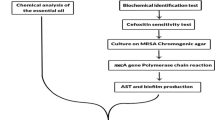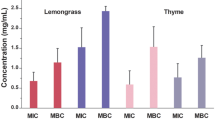Abstract
Greasy pig disease or exudative epidermitis, a generalized or localized skin disease affecting piglets, is mainly caused by Staphylococcus hyicus, although other staphylococcal species such as Staphylococcus aureus may also induce disease. Piglets with skin lesions can be treated systemically with antibiotics. However, antimicrobial resistance to β-lactam antibiotics are now frequently observed in S. hyicus and S. aureus isolates. In this study, the antibacterial activity of plant essential oils as well as their ability to potentiate the effect of several antimicrobial compounds against S. hyicus and S. aureus were investigated with a view to a potential use as skin disinfectants. Among ten essential oils tested, those from cinnamon, thyme, and winter savory were the most active with minimal inhibitory concentration (MIC) and minimal bactericidal concentration (MBC) values ranging from 0.078 to 0.313% (v/v). Using a fluorescent probe with DNA affinity, it was found that thyme and winter savory oils act, at least in part, by disturbing the bacterial membrane integrity. At concentrations below the MIC, thyme and winter savory oils reduced biofilm formation by S. hyicus. Moreover, a treatment of pre-formed biofilms of S. hyicus with cinnamon or thyme oils significantly decreases its viability. Synergistic interactions between essential oils, more particularly from thyme and winter savory, and penicillin G, chlorhexidine or nisin, were observed. This study supports the therapeutic potential of essential oils as topical therapeutic agents against exudative epidermitis.



Similar content being viewed by others
References
Ali SM, Khan AA, Ahmed I, Musaddiq M, Ahmed KS, Polasa H, Rao LV, Habibullah CM, Sechi LA, Ahmed N (2005) Antimicrobial activities of eugenol and cinnamaldehyde against the human gastric pathogen Helicobacter pylori. Ann Clin Microbiol Antimicrob 4:20
Bouhdid S, Abrini J, Amensour M, Zhiri A, Espuny MJ, Manresa A (2010) Functional and ultrastructural changes in Pseudomonas aeruginosa and Staphylococcus aureus cells induced by Cinnamomum verum essential oil. J Appl Microbiol 109:1139–1149
Burt S (2004) Essential oils: their antibacterial properties and potential applications in foods—a review. Int J Food Microbiol 94:223–253
Davies PR (2016) Overview of exudative epidermitis. Veterinary manual. Merk Sharp and Dohme Corp., Kenilworth
Eliopoulos GM, Moellering RC (1996) Antimicrobial combinations. In: Lorian V (ed) Antibiotics in laboratory medicine. Lippincott Williams and Wilkins, Baltimore, pp 330–396
Foster AP (2012) Staphylococcal skin disease in livestock. Vet Dermatol 23:342-e63
Frana TS (2012) Staphylococcosis. In: Zimmerman JJ, Karriker LA, Ramirez A, Schwartz KJ, Stevenson GW (eds) Diseases of swine, tenth edition. Wiley-Blackwell, Chichester, pp 834–840
Hansen JN (1994) Nisin as a model food preservative. Crit Rev Food Sci Nutr 34:69–93
Nishifuji K, Sugai M, Amagai M (2008) Staphylococcal exfoliative toxins: “Molecular scissors” of bacteria that attack the cutaneous defense barrier in mammals. J Dermatol Sci 49:21–31
O’Bryan CA, Pendleton SJ, Crandall PG, Ricke SC (2015) Potential of plant essential oils and their components in animal agriculture - in vitro studies on antibacterial mode of action. Front Vet Sci 2:35
Ohno T, Kita M, Yamaoka Y, Imamura S, Yamamoto T, Mitsufiji S, Kodama T, Kashima K, Imanishi J (2003) Antimicrobial activity of essential oils against Helicobacter pylori. Helicobacter 8:207–215
Palaniappan K, Holley RA (2010) Use of natural antimicrobials to increase susceptibility of drug resistant bacteria. Int J Food Microbiol 140:164–168
Pandey AK, Kumar P, Singh P, Tripathi NN, Bajpai VK (2016) Essential oils: sources of antimicrobials and food preservatives. Front Microbiol 7:2161
Park J, Friendship RM, Weese JS, Poljak Z, Dewey CE (2013) An investigation of resistance to β-lactam antimicrobials among staphylococci isolated from pigs with exudative epidermitis. BMC Vet Res 9:211
Sharifi-Rad J, Sureda A, Tenore GC, Daglia M, Sharifi-Rad M, Valussi M, Tundis R, Sharifi-Rad M, Loizzo MR, Ademiluyi AO, Sharifi-Rad R, Ayatollahi SA, Iriti M (2017) Biological activities of essential oils: from plant chemoecology to traditional healing systems. Molecules 22:1
Singh A, Gupta R, Tandon S, Pandey R (2017) Thyme oil reduces biofilm formation and impairs virulence of Xanthomonas oryzae. Front Microbiol 8:1074
Sun K, Lei Y, Wang R, Wu Z, Wu G (2017) Cinnamicaldehyde regulates the expression of tight junction proteins and amino acid transporters in intestinal porcine epithelial cells. J Anim Sci Biotechnol 8:66
Turgis M, Dang Vu K, Dupont C, Lacroix M (2012) Combined antimicrobial effect of essential oils and bacteriocins against foodborne pathogens and food spoilage bacteria. Food Res Int 48:696–702
van Duijkeren E, Jansen MD, Flemming SC, de Neeling H, Wagenaar JA, Schoormans AH, van Nes A, Fluit AC (2007) Methicillin-resistant Staphylococcus aureus in pigs with exudative epidermitis. Emerg Infect Dis 13:1408–1410
Wegener HC, Schwarz S (1993) Antibiotic-resistance and plasmids in Staphylococcus hyicus isolated from pigs with exudative epidermitis and from healthy pigs. Vet Microbiol 34:363–372
Zhu H, Du M, Fox L, Zhu MJ (2016) Bactericidal effects of Cinnamon cassia oil against bovine mastitis bacterial pathogens. Food Control 66:291–299
Acknowledgements
This study was supported by the Natural Sciences and Engineering Research Council of Canada. The authors wish to thank Dr. Marcelo Gottschalk (Université de Montréal) for providing bacterial strains.
Author information
Authors and Affiliations
Corresponding author
Ethics declarations
Conflict of interest
No conflict of interest declared.
Additional information
Communicated by Yusuf Akhter.
Rights and permissions
About this article
Cite this article
Vaillancourt, K., LeBel, G., Yi, L. et al. In vitro antibacterial activity of plant essential oils against Staphylococcus hyicus and Staphylococcus aureus, the causative agents of exudative epidermitis in pigs. Arch Microbiol 200, 1001–1007 (2018). https://doi.org/10.1007/s00203-018-1512-4
Received:
Revised:
Accepted:
Published:
Issue Date:
DOI: https://doi.org/10.1007/s00203-018-1512-4




